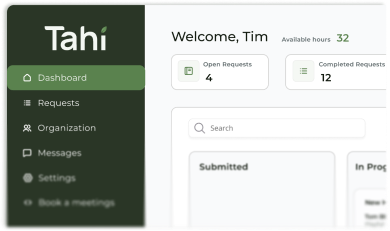Task Queue
A task queue is your dedicated project list in a design subscription. You add and prioritise requests, and we work through them one at a time for focused quality.
How does a task queue work with a Webflow subscription?
Think of a task queue as your project's command centre. Within your dedicated client dashboard, you have a space to add every single request you can think of for your website. This could be anything from designing a new landing page in Figma, developing a new feature in Webflow, or even creating a small graphic for a blog post.
Once your requests are in the queue, you can easily prioritise them by dragging and dropping them into the order you want them completed. Our team will always pull the request from the top of your list. This simple system removes the need for constant meetings about priorities and ensures we are always working on what is most important to your business right now. It provides a clear, documented workflow for everyone involved.
What are the benefits of a one-request-at-a-time model?
The primary benefit is uncompromising quality. When our designers or developers focus on a single request, they can dedicate their full attention and expertise to it. This 'deep work' approach minimises context-switching, which is a common cause of errors and rushed outcomes. It means your project gets the careful consideration it deserves, resulting in a higher quality deliverable.
This model also creates a predictable rhythm and faster turnaround for each individual task. While we only work on one thing at a time, that one thing moves from start to finish efficiently. This is a stark contrast to traditional agency models where your project might be one of a dozen being juggled, often leading to your smaller but important tasks getting pushed back for weeks. With a task queue, you see consistent, focused progress.
Can I add unlimited requests to my task queue?
Yes, absolutely. The 'unlimited' part of a subscription service refers to your ability to add as many requests to your queue as you like. There is no cap on the number of tasks you can log. This ensures that as soon as one task is completed, there is always another one ready for us to start on, eliminating downtime and keeping your project momentum going.
It's important to understand that the output is determined by the complexity of each request, not just the quantity. A simple icon set might be completed in a day, while a comprehensive new page design in Figma will naturally take more time. We believe in being transparent about this so you always have a realistic understanding of the workflow and progress through our clear process.
How should I structure my requests for the task queue?
Clarity is key to efficiency. The more detailed and well-defined your request is, the faster our team can understand your vision and deliver exactly what you need. A great request typically includes a clear, descriptive title, a detailed explanation of the goal, and any necessary assets like copy, images, or brand files.
If you have examples of what you like or specific inspiration, linking to them is incredibly helpful. For design requests originating from Figma, clear annotations and comments within the file can save a huge amount of back-and-forth. Taking a few extra minutes to structure your request properly helps us get it right the first time, which ultimately saves everyone time and prevents scope creep.
How can a task queue bring clarity to my Webflow projects?
Managing a digital project can often feel chaotic, with priorities scattered across email chains, Slack messages, and various documents. A task queue system, managed through a central dashboard, replaces that chaos with a single source of truth. It consolidates all your project needs into one organised, prioritised list.
At Tahi Studio, our client dashboard is designed to provide this exact clarity. It gives you a constant, real-time view of what's being worked on, what's next in the queue, and what has been completed. This streamlined process allows you to offload the mental burden of project management and focus on your core business, confident that your Webflow presence is moving forward with focused, expert attention through our partnership approach.







